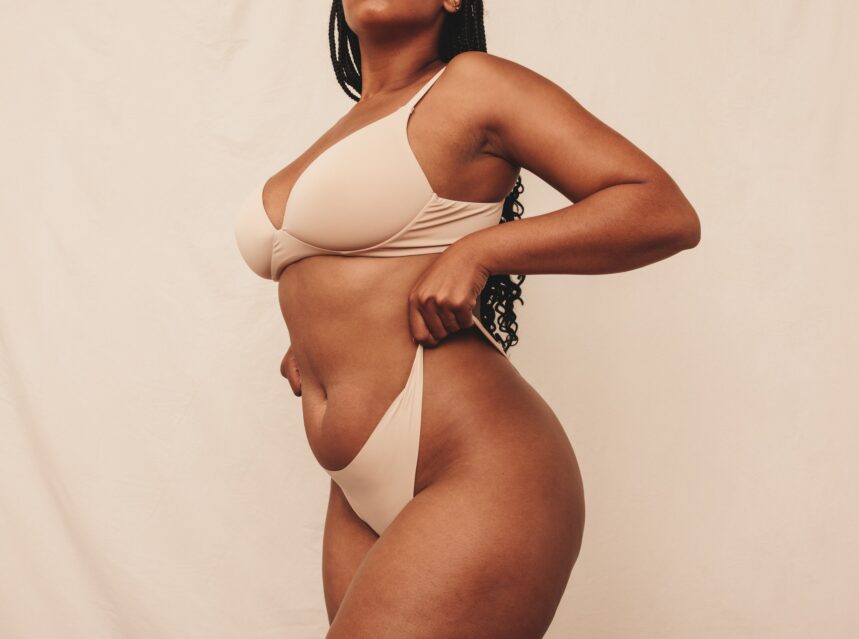How to Shave Pubic Hair for the Smoothest, Safest Results

If you’re wondering how to shave pubic hair the right way, you’re definitely not alone. There’s a lot of curiosity (and variety) out there when it comes to hair down there. Case in point: One TikToker recently asked her followers about current pubic hair trends and the responses were all over the place. (Our favorite: “I put mine in a messy bun so that it’s curly in the morning.”) We’ll just state the obvious now: What you choose to do—or not do—with your pubic hair is 100% a matter of personal preference.
Maybe you want to leave it all. Maybe you like to go completely bare. Maybe you prefer to trim it from time to time. Either way, do your thing. But if shaving your pubic hair is part of your normal routine or you want to experiment with it, it’s important to know how to do it safely and successfully.
Here, dermatologists share exactly how to shave pubic hair, including the best tips, tricks, and product picks that will ensure your skin is smooth and healthy post-shave.
Why do you even have pubic hair?
It’s not entirely clear why people have pubic hair. When it comes to those of us with vaginas, there is some thought that it might provide protection against dirt entering the vagina, as well as against friction from exercise or sex.
There is also the (unproven) theory that pubic hair may carry pheromones that signal when you have reached reproductive maturity (and, in turn, possibly help you attract a partner to reproduce with). While the research on this is inconclusive at best, the fact is that most people begin to sprout pubic hair when they reach puberty, a phase marked by other hair growth—like armpit hair and facial hair—that can show up in different spots depending on a person’s sex assigned at birth, as well as muscle growth, breast development, a deepening voice, and acne, SELF previously reported.
Just because pubic hair is a natural part of human development doesn’t mean you’re obligated to keep it, though—just like various pubic hair removal trends don’t mean you’re obligated to groom it. “In modern life, pubic hair really doesn’t have much functionality and it’s not essential, so there’s no reason why you shouldn’t remove it if you want to,” Elyse Love, MD, a board-certified dermatologist at GlamDerm in New York City, tells SELF. That being said, “As long as you’re practicing proper hygiene, there’s also no issue with not removing pubic hair, either,” she adds.
So you want to shave your pubic hair? Let’s go over the possible risks first.
While you absolutely can shave your pubic hair yourself, if you aren’t intentional about how you do it, you can increase the risk of irritation, cuts, ingrown hairs, and skin infection. To that end, you absolutely should not grab any old razor and get to work; a dull razor can up the likelihood of all of the above. Instead, make sure you have everything necessary to follow the steps we’re about to go through. A multi-step shaving process may seem over the top, but knowing that there are some risks involved will hopefully make following these steps feel more worth it.
As a baseline, you’re going to need body soap and water, a clean and sharp razor (more on that below), shaving cream or gel, and a moisturizer to use when you’re finished. Keep reading for our product recommendations and detailed directions for how to shave down there.
How to shave pubic hair safely
“There are certain steps that are important for shaving pubic hair,” Gary Goldenberg, MD, assistant clinical professor of dermatology at the Icahn School of Medicine at Mount Sinai Hospital, tells SELF. Many of them are also key if you’re shaving other areas like your legs or face, he adds.
But before we get into the specifics, we have an important PSA (pubic shaving announcement): Never put any of the products below (moisturizers, shaving creams, scrubs, after-shave lotions) in the vagina, or you’ll risk disrupting the bacterial and/or pH balance down there, which could up your risk of painful inflammation or even infection. Stick with your upper vulva (mons pubis) and outer lips (labia majora). Okay, with that out of the way, here’s what to do:
Trim first if necessary: If your pubic hair is a bit long, consider trimming it with scissors or a bikini trimmer before you start shaving. Otherwise, excess hair can end up clogging up your razor and impact its ability to deliver a smooth shave, Dr. Love says. Yes, it’s okay to cut your pubic hair with scissors—just make sure you’re *carefully* staying above the surface of the skin, of course, she notes.
Use a separate razor for this area: Some people have a separate razor for different body parts, but if you don’t, Dr. Goldenberg recommends paying attention to the order in which you shave. “I would start with your pubic hair so that the razor is the sharpest,” Dr. Goldenberg says. Then he suggests moving to other body parts if you shave anywhere else. “Obviously, you have to be careful because the sharper the razor, the easier it is to cut yourself, but a sharper razor does make a difference,” he says. That brings us to our next point….
Always use a sharp, single- or dual-blade razor: Dr. Goldenberg says that sharp razors allow you to get a close shave without pressing too firmly on your skin, which can cause irritation and cuts. While many razors have an indicator strip that tells you when the blade is dulling, Dr. Goldenberg says you might need to change your razor more often than the strip would suggest.
Pay attention to whether the razor “pulls the hairs instead of easily cutting them,” he says. When the razor pulls, it stretches hair and skin, which can increase the chance of skin infection and irritation, Dr. Goldenberg explains. So if it seems like your razor is dragging instead of cutting (i.e. there are still hairs left even after a couple of passes or you feel a slight, uncomfy tug while shaving), it’s time to replace it. If you’re looking for a general marker, Dr. Love recommends swapping out your razor after every five shaves, per guidelines from the American Academy of Dermatology (AAD).
Similarly, less is more when it comes to the number of blades on your razor for pubic hair shaving. “Razors with a single or double blade allow for much more precision. You can easily control the swipe of the blade, much more so than you can with razors that have multiple blades,” Dr. Love explains. (According to the AAD, this may also help minimize the likelihood of irritation and razor bumps.) The Gillette Simply Venus 2 Blade Disposable Razors ($7, Walmart) fit the bill.
Shave at the end of your shower: You’ll get the closest, smoothest shave when both the hair and skin are soft, Dr. Love says. Reserve shaving pubic hair as the final step of your shower routine, after the water and steam have had some time to soften the hair and skin.
Start with soap and water: Begin by making sure that your skin is clean and prepped for shaving. “Wash the area with a little mild soap and warm water,” Dr. Goldenberg says. Per our previous point, using warm or hot water will allow for a closer and smoother shave, he explains.
Apply shaving cream: Do not, we repeat, do not shave dry. “Shaving cream decreases the amount of friction between the razor blade and your skin, ensuring it glides more smoothly and decreasing the likelihood of irritation,” Dr. Love explains. There’s a good reason why it’s called razor burn—those painful red bumps are an indication that the blade irritated and inflamed the skin, she adds. Make sure to fully protect your skin by covering the entire area you’re shaving in an even layer of shaving cream.
While any shaving cream is better than none, because we’re talking about a sensitive area of the body, Dr. Love recommends choosing an option that’s free of alcohol (which can be drying) and fragrance, especially if your skin is sensitive in general. Bonus points if it contains moisturizing and soothing ingredients, she says. We like EOS Shea Better Sensitive Skin Shave Cream ($6, Target), which is fragrance-free and touts skin-soothing colloidal oatmeal.
Body lotion or hair conditioner can possibly replace shaving cream in a pinch, but Dr. Love doesn’t recommend it in general. “Lotion isn’t made to be a gliding medium and isn’t designed to work with wet skin” she explains. “And hair conditioner is meant to soften hair, not protect the skin, so it may not be a good substitute.” That said, if a moisturizing lotion, conditioner, or even body wash allows your razor to easily glide over your skin and doesn’t cause any post-shave irritation, then no harm, no foul.
Be gentle: Though it’s tempting to go over the same patch of skin until it’s ultra-smooth, resist the urge to shave the same spot too many times—keep it to one or two passes to avoid irritation. And if you’re wondering which direction to shave pubic hair in, always shave in the direction of hair growth, the Mayo Clinic says. This not only ensures a closer shave, but it also minimizes the likelihood of irritation and ingrown hairs, Dr. Love adds.
Rinse your razor after each stroke: As you might imagine, a razor that’s clogged with hair and shaving cream isn’t going to be as effective or as sanitary. (FYI, this is a good shaving tip for anywhere on the body, not just the pubic area, Dr. Love points out.)
Then rinse and dry the area: Dr. Goldenberg suggests rinsing the area with cooler water (to soothe skin and prevent inflammation) and patting yourself dry with a clean towel to get rid of excess hair and shaving cream.
Don’t forget to moisturize: Finish your shave with the moisturizer of your choice. While Dr. Goldenberg says many of his patients use a rich moisturizer like coconut oil, “I don’t love the idea of something very heavy, like oil, because you can [clog] pores,” he explains. He does add the caveat that if you’ve used a heavier product that you like, you should feel free to stick with what works. “But if you’re shaving for the first time, I would prefer a lighter lotion or a cream just to make sure that you don’t get pimples, essentially from [blocking] the follicles or the pores,” he says.
We recommend a gentle fragrance-free moisturizer like CeraVe Moisturizing Cream for Normal to Dry Skin ($16, Amazon). Dr. Love adds that even a plain, fragrance-free aloe vera gel can be a good option to help add some moisture and also soothe any potential irritation. One to try: Earth’s Daughter Aloe Vera Gel ($12, Amazon).
Prevent ingrown hairs: Ingrown hairs happen when hair grows back into the skin instead of out and away from the body, causing inflammation and bumps, the Mayo Clinic explains. This is more likely with coarser, curlier hair, which is why ingrown hairs can be so common after removing your pubic hair. “I find that shaving tends to be less likely to cause ingrown hairs than other hair removal methods such as waxing or sugaring,” Dr. Love explain. “Ingrown hairs are a problem with hair regrowth. When you’re shaving, you can continuously keep shaving the hair so that it doesn’t have the chance to grow out much, which it has to do before you can wax or sugar again.”
Still, following the above steps to help prepare the skin for shaving can help cut down on ingrown hairs. Exfoliating between shaving sessions—again, being mindful to keep any product away from your vagina and on your bikini area only—is also a good idea, according to Dr. Love: “By exfoliating the surface of the skin, you’re removing dead cells and clearing a path for the hair to regrow.” She likes the Nécessaire Body Exfoliant ($30, Sephora), a gentle option that combines both chemical exfoliants and physical exfoliating ingredients.
You may also have luck with serums that are meant to prevent ingrown hairs (many of which have those gentle exfoliating acids). Tend Skin Women’s AfterShave/Post Waxing Solution ($16, Amazon), for example, contains the anti-inflammatory agent acetylsalicylic acid (aspirin).
How to remove pubic hair without shaving
If shaving isn’t your cup of tea, you have other options. Waxing is a popular choice for the pubic area; because it removes hair from the root rather than just cutting it at the surface of the skin, skin tends to stay smoother for longer. However, for the best results, experts recommend waiting until hair is at least one fourth to three fourths of an inch long, per the AAD, so you’ll need to be okay with letting it grow out between sessions. And while at-home waxing is an option, the bending and contortion required to effectively reach your entire vulva can make it quite challenging—not to mention the possibility of skin burns from the hot wax and skin tears from an improper technique, Dr. Love cautions. In other words, it’s safest to leave Brazilian bikini waxing up to the pros.
Laser hair removal is another route. It can be expensive and multiple sessions are required, though results are semi-permanent. You can see a pro or try an at-home laser hair removal device. However, if you want to take the DIY route, just be prepared: these tools aren’t as high-powered as the in-office versions, so the process can be much more time-consuming, as SELF previously reported. Electrolysis, which uses electrical currents to destroy hair follicles at the root, is the only known permanent hair removal method, but this treatment needs to be performed by a pro. There’s no way of permanently removing pubic hair at home, Dr. Love notes.
TL;DR: While shaving does need to be done regularly in order to maintain smooth, fuzz-free skin, it’s the easiest option for those looking for a quick, at-home hair removal method that you can do yourself. (Oh, and if you’re worried that the hair will grow back thicker, faster, or darker post-shave, don’t be. That’s a common myth, Dr. Love says. It may appear that way because shaving gives the hair a blunt tip, making it look coarser and feel stubbly, but the hair itself hasn’t changed.
Above all, if you choose to shave your pubic hair, just take your time.
Don’t rush this process. A 2012 article in the journal Urology estimated that from 2002 to 2010, there were 11,700 “grooming-related injuries” in the genital area (regardless of people’s sex assigned at birth), and researchers confirmed that 385 of those people wound up visiting the emergency room. What’s worse? A full 83% of the total injuries involved a razor.
In related (better) news, Dr. Love says you really can shave anywhere around the vulva, so long as you’re being gentle and have a stable hand. Of course, if you do experience any serious cuts or signs of infection (like an increasingly painful ingrown hair that’s filled with pus), it’s still a good idea to see your doc to be on the safe side. Remember—they’ve seen it all!


